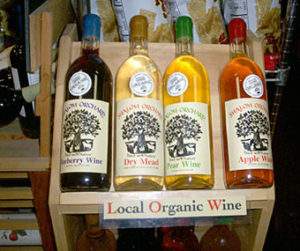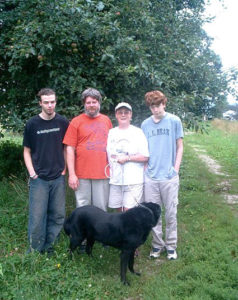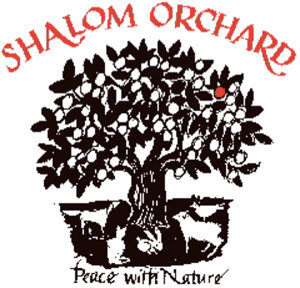 |
| A sampling of Shalom’s fruit wines. Photo by Frances Idlebrook. |
by Craig Idlebrook
So you want to start a vineyard in Maine. Before you plow up your squash patch, you might want to talk to some farmers who have tried growing grapes.
Dennis King has a small organic vineyard at King Hill Farm in Penobscot. Although he’s never sold his wine commercially, word has spread of his hobby.
“If I show up at a party without a couple of bottles of wine, they’d kick me out,” he jokes.
A 30-year veteran of Maine winemaking, King’s on his third set of grapes. Harsh winters killed his vineyard twice, and he saved a third planting only by ruthlessly pruning back frost damage. That was in 2003; by 2007, King’s grapes will be fully recovered.
King’s never been tempted to turn his winemaking into a commercial operation, saying it would ruin a good hobby – and because he believes Maine’s climate is too cold for reliable grape harvests. “I wouldn’t want to mortgage my farm on it,” he says. Others agree, but increasing research and experimentation are improving the potential for growing wine grapes in Maine; and for those who don’t want to take a chance with grapes, other fruits make good wine.
The Extension Perspective
Dr. David Handley, Maine’s Extension vegetable and small fruit specialist, often tries to talk over-enthusiastic farmers out of growing grapes for wine on a commercial scale. “People come to me and ask, ‘How much can I make growing grapes?’ I say, ‘ How much can you afford to lose?’”
Many wine grapes can’t survive Maine winters, Handley explains. They show bud injury at –5 to –10 degrees F., so one January cold spell could knock out production for a year. Temperatures of -15 to –20 degrees can kill a vineyard.
Even if grapes do overwinter, they may not build up the sugars necessary during our short growing season to make good wine. “You start out with two strikes against you,” Handley concludes.
Grapes can grow in Maine, however, as evidenced by the odd wild grapevine around the farm. In fact ‘Concord’ grapes, a variety commonly used in grape juice, thrive here (although much of Maine’s growing season is not long enough for them to ripen). Wild and ‘Concord’ grapes can be made into wine, Handley says, but that doesn’t mean the wine will be good. “You can make wine from dirty socks if you want to,” he remarks.
It gets worse: Pests can be problematic. Diseases can move from wild to cultivated grapes, and leafhoppers and Japanese beetles easily move from other crops to vineyards. Deer, rodents and turkeys can take their toll, and Handley has even known foxes and coyotes to sample vineyard fruits.
The Good News
Growing grapes in Maine may not be easy, but it isn’t impossible. In recent years, U.S. and Eastern European researchers have crossed hardy with more delicate winemaking varieties. In fact, many state agricultural agencies see winemaking as so valuable that they are pushing grape research, Handley says. He adds that organic grape growing is not much more difficult than conventional. Many organic methods control common pests. The key to success for organic growers, Handley notes, is recognizing problems before they get serious. Also, grapes grow relatively well in less-than-perfect soil – although, Handley warns, they do need sufficient nutrition to make them strong enough to survive winter.
Ultimately, Handley believes that the viability of a Maine vineyard depends on location. Not coincidentally, most of Maine’s commercial winemaking industry exists along the coast. “The ocean is a great buffer,” he says, adding that for northern growers, a large body of water can act as a heat sink to protect vines.
Being on the coast is also a boon for distribution. Since distributors often overlook small winemakers, producers’ best bet might be to market directly through their own wineries. For this to work, Handley recommends establishing a winery no more than 10 miles from a town with a strong tourist trade. However, finding affordable, well-drained land near popular coastal towns where you can grow a high-risk crop is questionable. “You’re going to be competing with everybody and his brother [for the land],” Handley admits.
The northern grape industry is getting a boost from grower Jerry Rodman of Litchfield, Maine, who dedicates his 2-acre vineyard to creating Maine-hardy grapes. Rodman began growing grapes as a hobby in 1986, when the slow pace of vineyard management complemented his hectic job. He originally intended to experiment with a few varieties of seedless grapes, but didn’t like the limited options available for his climate, so he began to breed his own in 1992. Now, his 2 acres have as many vines as a normal vineyard would have in six, since any that don’t meet his standards will be rogued out. He manually crosses different varieties, then plants the offspring and waits to see how they react to Maine’s winters with minimal protection.
Breeding experimental table grape varieties is a lot quicker work than growing possible wine varieties, Rodman says. For a table grape, all he has to do is grow the vine to fruition, then sample its taste and texture. But with winemaking grapes, he must make and age small batches of wine to see how the grape performs. The process, usually involving just one vine, is riddled with trial and error and can take years, Rodman says, adding, “If you’re doing it for a living, you’re in trouble.”
Rodman does think that winemaking in Maine is not only possible but is also a growing concern. He’s heard of several good winemaking businesses that have opened here in recent years. “I’m more optimistic than pessimistic about the future,” he notes, but adds that a great wine usually isn’t enough for a Maine winemaking business to survive. “It’s probably more a matter of good business sense” and of coupling winemaking with another customer draw, such as a restaurant or B&B business.
Rodman recommends starting small and having a business plan before starting a vineyard. Find a site that receives full sun and has a good southern slope where water and air drain well. The soil should be fertile but not too rich, with a pH of 5.5 to 6.5 and plenty of organic matter. To provide extra heat, which benefits grapes, you could grow vines against a stone wall, near a large boulder, or by the south side of a building, suggests Fedco Trees.
Several varieties are available. The latest Fedco Trees catalog, for instance, offers seven hardy winemaking grape varieties. (See fedcoseeds.com; techniques for pruning and trellising grapes are described in the catalog as well.) Noting that “there aren’t a lot of bulletproof grapes out there, but there are a few reliable [varieties],” Rodman suggests, “Pick several good varieties and give it a try!” (Grapes generally do not need a different variety for pollination.) He recommends trialing varieties from Fedco to see what will work in your location. His other recommendations for trialing include ‘Itaska,’ a red wine grape newly released from the University of Minnesota; it’s “pretty good – probably a little less acidic than ‘Frontenac,’” which is offered by Fedco. Cornell bred ‘Noiret’ in 1973 and has just released the red wine grape; it’s “worth trialing,” says Rodman. And ‘Concord Seedless,’ which is not highly productive, might be good for homeowners, since it ripens about three weeks earlier than ‘Concord.’ If you don’t want to wait for wine, Rodman says that ‘Lorelie,’ a table grape, is “very flavorful, very nice eating.”
 |
| Charlotte Young and Jim Baranski of Shalom Orchard, with two of their children, Ric and Jacob, and the family dog. Photo courtesy of Shalom Orchard. |
The Few, the Brave, the Grapeless
Despite the odds, wineries have sprouted up along Maine’s coast, with four in tourist-laden Hancock County alone. That isn’t to say there are four vineyards in Hancock County. Many Maine winemakers forgo grapes and make wine from more reliable crops, such as apples, blueberries, blackberries and even rhubarb. Three of the four Hancock County wineries are non-grape based, and all offer at least one fruit wine.
Shalom Orchard Winery in Franklin is Maine’s only certified organic winery, and co-owner Charlotte Young believes Shalom is one of only 11 certified organic wine producers in the country.
When Young and her husband, Jim Baranski, moved to the Franklin farm, they had little intention of running a winery but were focused on resurrecting soil that had been abandoned for two and a half years. “The only groundcover was wild strawberries,” Baranski says.
Still, Young appreciated the farm’s well-established apple orchard immediately. “All I could think of was, ‘There are 1,000 apple trees and they’re already in the ground,’” Young recalls. Since no prohibited substances had been applied to the abandoned farm recently, it was ready for organic certification in half a year. Baranski and Young added lime and manure to the soil and soon had 20 acres in production.
 |
Young and Baranski both had winemaking backgrounds. Young once co-owned and operated a conventional, commercial vineyard in Connecticut, and Baranski learned to make mead through the Society for Creative Anachronisms, which researches and recreates pre-17th century European history. (See www.sca.org.) So Baranski began making apple wine from their excess fruit. His initial attempts were so successful that the couple soon had too much wine around the house. “It was more than I could stand,” Young laughs.
Young convinced her husband to try commercial winemaking. They received their license and, in 2002, sold their first wine. Since then, Shalom has offered a dizzying number of wines and meads, including pear, apple, blueberry, blackberry, elderberry, cranberry, wintergreen, ginger and maple syrup.
These are not sweet wines, since, during fermentation, yeast feeds on the fruits’ sugars. In fact, Baranski often has to add sugar. He likes to keep the process going until he gets a dry wine that would be a suitable accompaniment for meals.
Many wines on the market are made from organic ingredients, but few are certified organic, because most winemakers stop fermentation with yeast-killing sulfites before the wine reaches the bottle. At Shalom, however, Young and Baranski trust fermentation to run its course once the wine has been put into the bottle. This means customers might get a surprise pop of the cork when opening Shalom wine, or even a little fizz in their drink. “This is the nature of the difference in organic wine,” Young says. “It’s a living drink.”
An added bonus is that organic wine is one of the few that can be labeled vegan. Many other winemakers use chemicals derived from egg whites or fish scales during fermentation.
Making wine organically hasn’t presented insurmountable challenges. Baranski says the biggest problem he’s encountered is finding enough organic sugar or honey. He estimates that he buys more than a ton of organic sugar from Texas each year.
Baranski stocks their wine in natural food stores and good wine shops, and they sell it at their farm and in conjunction with their two-room bed and breakfast (but not for breakfast, usually) during warm weather.
Craig Idlebrook is a freelance writer. Two glasses of wine would put him under the table. He can be reached at [email protected].
Contact Shalom Orchard Winery at 565-2312 or [email protected], or visit www.shalomorchard.com.
